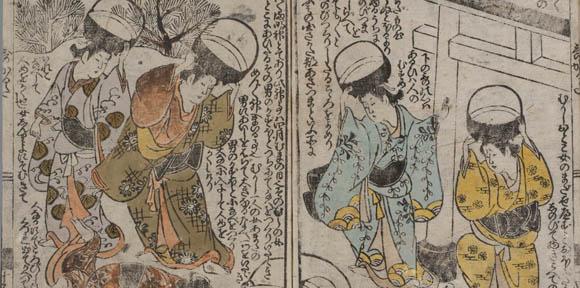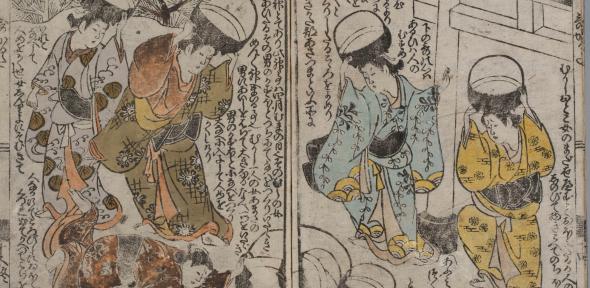
Dr Laura Moretti, from the Faculty of Asian and Middle Eastern Studies at Cambridge, came across an unknown children’s picture-book, dating from 1766, under the title of Ise fūryū: Utagaruta no hajimari (The Fashionable Ise: The Origins of Utagaruta) while on a study trip with her students.
The British Library copy, part of the collection belonging to Sir Ernest Satow, a 19th century British scholar and diplomat, is a picture-book adaptation of Ise Monogatari. Translated into English as The Tales of Ise, it is one of the most important works in Japanese literature and was originally composed probably in the late 9th century following the protagonist, Ariwara no Narihira, through his many romances, friendships and travels.
The Tales of Ise has since been adapted and reinterpreted continually down the centuries as part of the canon of Japanese literature.
“If we were to hazard a comparison, The Tales of Ise could be seen as the equivalent of the works of Shakespeare in terms of canonical status in Japan but I had never heard of or seen a children’s adaptation before – no-one knew of this book,” said Moretti. “This is a missing piece of the jigsaw. No one ever knew if it had been rewritten for children – but now we know. And it was sitting in the British Library all along.”
Dr Moretti’s new book, Recasting the Past (Brill, 2016), presents a full-colour reproduction of the 18th century edition, alongside a transcription in modern Japanese, an English translation, and textual analysis. The publication of the 1766 adaptation of the Tales of Ise fills a gap in scholars’ understanding of the work’s history. Although much scholarship has taken place on the reception of Tales of Ise and its target audiences in different epochs, no one has previously explored the age of its readership.
The 1766 introduction by the publisher shows that the book was intended to be read by children and there are various clues to support this view. The main character Narihira first appears as a young boy at school, a portrayal which encourages young people to identify with him. The whole text is also written using mainly the phonetic syllabary which could be understood by readers with only two years of schooling. The story was also abbreviated to include only 13 of the original 125 episodes – making it easily accessible to a broad readership and was useful for introducing those with basic literacy to Japan’s cultural heritage. The book would have educated children in the narrative of The Tales of Ise as well as the aesthetic quality of the poetry.
Moretti, though, counters the notion that only children would have read Utagaruta no hajimari, and argues that the text could also work as a substitute of the The Tales of Ise for those adults with limited linguistic and cultural literacy.
Now, after several years of negotiating the necessary permissions to use the two complete extant copies (one held at the National Institute of Japanese Literature and the other at the Gotoh Museum, both in Tokyo; alas the British Library copy has only one volume of three) and to finish the transcription, translation and textual analysis, Utagaruta is available again for readers to enjoy – more than 250 years after it was first printed.
While graphic novels and comic books such as manga remain hugely popular in Japan and across the world today, instances of books where images and text are interdependent abound in pre-modern and early-modern Japanese literature. In this specific case, Moretti shows that the primary function of images was to complement the prose by filling in the gaps left by the narrative. Images set the scene for the story and helped to characterize the protagonists by depicting their dress and physical appearance.
Moretti believes that studying this children’s adaptation can give a contribution to the study of children’s literature in general, discovering aspects that might not be apparent in other cultures.
“Utagaruta no hajimari, for example, is trying to draw children into the world of the adult, rather than shield them from it by introducing children to sex and appropriate romantic behaviour,” she said.
“A vast number of early-modern Japanese picture-books that adapt canonical literature awaits to be studied. This research is the first step in the foundation of this field of study. If appropriately developed, it has the potential to shed light onto new sides of children’s literature as well as to advance in the understanding of how early-modern Japanese graphic prose functioned.”
A chance discovery in the British Library has led to the discovery and reproduction of the earliest-known children’s adaptation of one of Japan’s greatest works of literature.

The text in this work is licensed under a Creative Commons Attribution 4.0 International License. For image use please see separate credits above.



